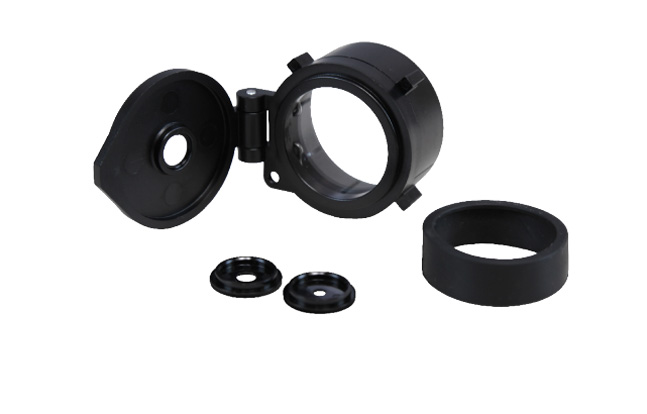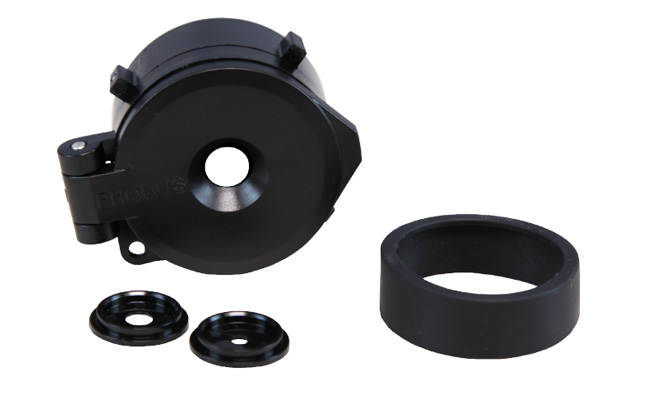The Hoplite Night Vision Focusing Cover works to reduce far-to-near focusing time via hinged aperture control. Patented technology provides unrivaled refocusing speed for target identification of threats inside of 5 feet and out to 300 yards, giving soldiers a critical advantage by allowing NVG’s to stay focused out to infinity while simultaneously allowing 20/20 visual acuity of near threats.
Soldiers commonly modify their dust covers to gain this same advantage only to discover unreliable transitioning and functional inconsistency. Meanwhile, tens of thousands of NVG’s are damaged each year due to lens scratches and cracks. The improved Hoplite design replaces your existing dust cover and sacrificial lens. Experience 21st century technological advantage while protecting your gear!
The Hoplite kit consists of the Hoplite body/cover assembly, two accessory apertures and a rubber adapter for the PVS-15 and 18. The body has a hinged dust cover top, which flips open and closed on a hinge. There is no detent; it relies on friction to keep it closed and open. The body has an integral lanyard loop for securing it to the NV device to prevent loss. The Hoplite body incorporates a rotating tension lock which decreases the inside diameter of the body so that it locks onto front of the NVG. Rotating the tension lock clockwise (when looking from the front) ‘contracts’ the inside of the body, which tightens its grip on the NVG objective lens. You can see the travel-limiting pin inside the body that moves in a slot in the photos below. The inside of the body has slits/cutouts. When the tension lock is tightened, the gaps close ever so slightly reducing the inner diameter of the body to secure it to the objective lens. The PVS-15 and 18 have smaller diameter objective lenses so the included rubber adapter is used with them. The Hoplite is made of polycarbonate and 18-8 stainless steel (for the retaining ring and small parts).
Advertisement — Continue Reading Below
The Hoplite works on the same principle that’s used on any camera lens to deepen the depth of field: by manipulating the aperture to adjust the depth of field. With photography, a higher f-stop (smaller aperture) deepens the depth of field, which means that there’s a wider range of distances from the point of optimum focus that objects will appear to be in focus. With a smaller f-stop (larger aperture), the depth of field is shallower, so that fewer object will be in focus as the distances vary from the point of optimum focus.
-
Tech Specs
Weight: .88 ounce
Length: 26 mm
Width: 55 mm
Depth: 15.9 mm
Material: Polycarbonate and 18-8 Stainless Steel
Advertisement — Continue Reading Below
Available for these models:
AN/PVS-7
AN/PVS-7B/D
ANVIS-9
AN/PVS-14
AN/PVS-15
AN/PVS-18
BNVD
BNVD-G
AN/PVS-23 (F5050YG)
M944 Pocket Scope
NEPVS-14
See more at phokusresearch.com.
Advertisement — Continue Reading Below

























